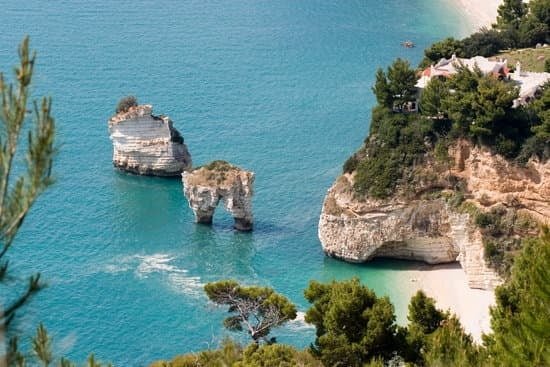Italy has long been a picturesque and alluring travel destination, captivating visitors with its rich history, stunning architecture, delectable cuisine, and vibrant culture. Each year, the country welcomes an impressive number of tourists from around the world.
In this blog post, we will delve into the question: how many people travel to Italy each year? From historical tourism trends to the impact of popular attractions and events, we will explore the factors that contribute to Italy’s allure as a top travel destination.
For decades, Italy has been a magnet for travelers seeking a blend of ancient wonders and modern charm. The country’s timeless appeal is evident in its continued popularity as a go-to destination for tourists. With an array of historical sites, breathtaking landscapes, and world-renowned art and architecture, it’s no surprise that Italy draws in millions of visitors annually.
As we navigate through this blog post, we will examine the various elements that contribute to Italy’s status as a premier tourist hotspot. From cultural influences to seasonal fluctuations and iconic landmarks, we will uncover the reasons behind the significant influx of tourists into the enchanting country of Italy. So let’s embark on this journey to discover just how many people travel to Italy each year and what makes this captivating nation so irresistible to travelers worldwide.
Historical Tourism Trends in Italy
Italy has long been a favorite destination for travelers around the world. The country’s rich history, stunning architecture, and delectable cuisine have drawn in visitors for centuries.
In recent years, the number of tourists flocking to Italy has only increased, solidifying its position as one of the most popular travel destinations globally. In this section, we will delve into the historical tourism trends in Italy and explore how the number of people traveling to Italy each year has evolved over time.
Growth of Tourism in Italy
Over the past few decades, Italy has experienced a significant increase in tourism. With its iconic landmarks, beautiful landscapes, and vibrant culture, it’s no wonder that more and more people are choosing Italy as their vacation spot. According to official statistics, the number of international tourists visiting Italy has shown a steady rise year after year.
Number of Tourists Visiting Italy in Recent Years
In the past decade alone, Italy has welcomed millions of tourists annually. The country consistently ranks among the top tourist destinations worldwide, attracting a diverse range of visitors from all corners of the globe. With each passing year, the numbers continue to climb, showcasing the enduring appeal of Italy as a must-visit travel hotspot.
As we continue our exploration, we’ll take a closer look at some of Italy’s top tourist attractions and examine how these sites contribute to the ever-increasing influx of visitors to this enchanting country.
Italy’s Top Tourist Attractions
Italy is home to some of the most incredible tourist attractions in the world, drawing millions of visitors each year. Whether it’s the iconic Colosseum in Rome, the historic Vatican City, or the breathtaking Amalfi Coast, Italy has something to offer for every type of traveler. These popular attractions have a significant impact on the number of tourists visiting the country annually.
Top Tourist Attractions in Italy
– Colosseum: The Colosseum is an ancient amphitheater that once hosted gladiator battles and other events. Today, it attracts over 7 million visitors annually, making it one of Italy’s most visited landmarks.
– Vatican City: As the seat of the Catholic Church and home to renowned artworks such as Michelangelo’s Sistine Chapel ceiling, Vatican City welcomes millions of tourists each year.
– Amalfi Coast: Known for its stunning coastline, picturesque towns, and crystal-clear waters, the Amalfi Coast is a favorite destination for travelers seeking natural beauty and relaxation.
These attractions not only showcase Italy’s rich history and cultural heritage but also contribute significantly to its tourism industry. The allure of these must-see sights plays a major role in attracting a large number of visitors from around the globe each year.
Italy’s charm extends beyond its famous landmarks, with countless other cities and regions offering unique experiences that continue to draw tourists year after year. From art-filled Florence to romantic Venice, each destination adds to Italy’s appeal as a top travel destination. With so much to offer in terms of art, history, nature, and cuisine, it’s no wonder that Italy continues to captivate travelers worldwide.
Seasons and Tourist Arrivals
Italy is a country with varying tourist arrivals throughout the year, and this largely depends on the seasonal fluctuations. The peak tourist seasons in Italy generally coincide with the summer months of June, July, and August. During this time, the warm weather and longer days attract a large number of tourists to explore Italy’s cities, beaches, and countryside. Visitors flock to famous landmarks such as the Colosseum in Rome, the canals of Venice, and the art galleries of Florence.
On the other hand, Italy experiences lower tourist arrivals during the winter months, particularly in November through February. The colder temperatures and shorter days lead to a decrease in visitors during this time. However, some regions such as the Italian Alps see an influx of tourists during winter due to skiing and other winter sports activities. Additionally, coastal areas like Sicily still attract visitors seeking milder weather even during the off-peak season.
The shoulder seasons of spring (March to May) and autumn (September to October) also witness steady tourist arrivals in Italy. During these times, visitors can enjoy pleasant weather while avoiding large crowds at popular attractions.
The blooming flowers in spring and the vibrant fall foliage also add to the allure of visiting Italy during these transitional seasons. Overall, understanding how different seasons affect tourist arrivals is crucial for planning a visit to Italy and experiencing its unique charm throughout the year.
Impact on Visitor Experiences
The fluctuating tourist arrivals in Italy have a significant impact on visitor experiences. During peak seasons, attractions can be overcrowded with long lines and waiting times for popular landmarks such as the Leaning Tower of Pisa or Michelangelo’s David statue in Florence. On the other hand, traveling during off-peak periods allows for a more relaxed and enjoyable experience as tourists can explore sites without feeling rushed or overwhelmed by crowds.
Local Businesses and Hospitality Industry
The seasonal variations also affect local businesses and the hospitality industry in Italy. Tourism-dependent businesses such as hotels, restaurants, and tour operators experience higher demand during peak seasons while facing challenges during low seasons. Many establishments adjust their operating hours or even close temporarily during off-peak months due to reduced foot traffic from tourists.
Managing Sustainable Tourism
Understanding how different seasons impact tourist arrivals is essential for managing sustainable tourism in Italy. It allows authorities to implement measures aimed at distributing visitor flows more evenly throughout the year to alleviate overtourism pressures on popular destinations. By promoting off-peak travel through incentives or special events during low seasons, Italy can ensure that both visitors and locals benefit from a more balanced tourism experience year-round.
Popular Italian Cities and Their Tourist Influx
Italy is home to some of the most iconic and historically rich cities in the world, making it a top destination for tourists from all corners of the globe. Each year, millions of visitors flock to Italy to explore its stunning cities and immerse themselves in its vibrant culture and art. Below are some of the popular Italian cities and their annual tourist influx:
- Rome: The capital city of Italy, Rome is a treasure trove of ancient history and architecture. With attractions such as the Colosseum, the Roman Forum, and Vatican City, Rome attracts over 9 million tourists each year.
- Florence: Known as the birthplace of the Renaissance, Florence boasts world-renowned art museums, historic palaces, and beautiful cathedrals. It welcomes around 10 million visitors annually who come to admire masterpieces by Michelangelo, Leonardo da Vinci, and Botticelli.
- Venice: Famous for its canals, gondolas, and charming alleyways, Venice is a unique city that captivates around 30 million visitors every year. Travelers from around the world visit Venice to experience its romantic ambiance and unique architecture.
These cities not only offer a glimpse into Italy’s illustrious past but also provide an opportunity for travelers to indulge in exquisite cuisine and cultural experiences.
While these numbers indicate a high volume of annual visits to these cities alone, they are just a fraction of how many people travel to Italy each year The country’s rich history, breathtaking landscapes, delectable food, and warm hospitality continue to draw travelers in search of unforgettable experiences.
The Influence of Culture and Cuisine
Italy’s rich culture and delectable cuisine play a significant role in attracting a large number of tourists each year. The country’s cultural heritage dates back thousands of years, and this is evident in its art, architecture, music, and traditions. From the ancient ruins of Rome to the Renaissance art in Florence, Italy offers a unique blend of history and creativity that continues to captivate visitors from around the world.
Italian cuisine is celebrated globally for its delicious flavors and diverse regional specialties. From pasta and pizza to gelato and espresso, Italian food is beloved by food enthusiasts everywhere. The emphasis on fresh, high-quality ingredients and simple yet flavorful dishes has made Italian cuisine an integral part of the country’s identity and a major draw for tourists.
The combination of Italy’s rich cultural heritage and its delectable cuisine creates an immersive experience for travelers seeking to indulge their senses. Whether it’s savoring traditional dishes in a local trattoria or exploring historic landmarks like the Colosseum or the Pantheon, visitors can immerse themselves in Italy’s cultural tapestry while enjoying some of the most mouthwatering dishes on earth.
This unique fusion of culture and cuisine undoubtedly contributes to Italy’s enduring popularity as a top travel destination, attracting millions of visitors each year who seek to explore its culinary delights and vibrant heritage.
The Impact of Events and Festivals
Italy is known for its rich cultural heritage and vibrant festivals, which have a significant impact on the number of tourists visiting the country each year. Events such as the Venice Carnival and the Siena Palio are major attractions that draw visitors from around the world.
The Venice Carnival, held annually in the city of Venice, is one of the most famous and elaborate events in Italy. This two-week-long festival attracts millions of tourists who come to witness the colorful parades, masquerade balls, and various other festivities.
In addition to the Venice Carnival, the Siena Palio is another celebrated event that contributes to Italy’s tourist influx. This historic horse race takes place twice a year in the city of Siena and has been a tradition for centuries. The excitement and spectacle of this event draw thousands of spectators and participants, adding to the vibrant atmosphere of Italy’s tourism landscape.
These events not only showcase Italy’s cultural traditions but also provide an opportunity for visitors to immerse themselves in authentic Italian experiences. As a result, they play a crucial role in attracting tourists and contributing to Italy’s thriving tourism industry.
| Event | Number of Tourists (Annually) |
|---|---|
| Venice Carnival | Approximately 3 million |
| Siena Palio | Over 30,000 spectators and participants per race |
The Future of Tourism in Italy
Italy has long been a favorite destination for travelers around the world, known for its rich history, stunning landscapes, and delicious cuisine. But just how many people travel to Italy each year? The numbers are staggering. In 2019, Italy welcomed a record-breaking 94 million tourists. This marked an increase of 2.8% compared to the previous year, highlighting the growing popularity of this European gem as a travel destination.
One of the factors contributing to the continued growth of tourism in Italy is its timeless appeal. From ancient ruins to Renaissance art, there is something for everyone in this diverse country. Additionally, the influence of Italian culture and cuisine cannot be understated when considering how it draws in visitors from around the globe.
However, as with any tourist hotspot, Italy faces challenges that may impact its future as a travel destination. Issues such as overtourism, environmental concerns, and aging infrastructure could potentially have an effect on the number of tourists visiting each year. It will be crucial for Italy to find a balance between preserving its unique heritage and managing the influx of tourists if it hopes to sustain its position as one of the world’s most beloved travel destinations.
| Year | Number of Tourists (In Millions) |
|---|---|
| 2017 | 3 |
| 2018 | 6 |
| 2019 | 94 |
Conclusion
In conclusion, Italy continues to stand as one of the most popular travel destinations in the world, attracting a staggering number of visitors each year. Historical tourism trends have shown a steady increase in the number of tourists flocking to this beautiful country, with statistics indicating a significant rise in visitor numbers over the past decade.
The allure of Italy’s top tourist attractions such as the Colosseum, Vatican City, and Amalfi Coast has played a major role in drawing in travelers from around the globe.
Moreover, the popularity of Italian cities like Rome, Florence, and Venice has significantly contributed to the country’s high tourist influx. Each of these cities boasts its own unique charm and cultural significance, making them irresistible to travelers looking for an authentic Italian experience. Additionally, Italy’s rich culture and delectable cuisine have continued to attract a large number of tourists each year, further solidifying its reputation as a must-visit destination.
As we look towards the future, it is clear that Italy’s position as a top travel destination remains promising. While there may be potential challenges that could impact tourist numbers in the coming years, it is evident that Italy’s timeless appeal will continue to draw in visitors from all corners of the world.
With its breathtaking landscapes, world-renowned landmarks, and unparalleled cultural experiences, Italy is poised to maintain its status as one of the most sought-after travel destinations for many years to come.
Frequently Asked Questions
How Many Tourists Go to Italy a Year?
Italy is one of the most-visited countries in the world, welcoming around 60 million tourists annually. With its rich history, art, culture, and cuisine, Italy’s attractions draw visitors from all over the globe.
How Many People Come to Italy Each Year?
Each year, Italy sees millions of people flocking to its iconic cities like Rome, Venice, Florence, and Milan, as well as its beautiful coastal regions and picturesque countryside. The country’s diverse offerings make it a popular destination for many travelers.
Where Does Italy Rank in Tourism?
Italy consistently ranks among the top tourist destinations globally. With its renowned landmarks such as the Colosseum and the Leaning Tower of Pisa, along with its stunning landscapes and delicious food and wine, Italy’s appeal to tourists remains strong year after year.
Its position as a cultural and historical hub ensures that it remains a top choice for travelers seeking enriching experiences.

I’m a passionate traveler, writer, and Italophile. My fascination with Italy’s history, art, and culture has led me on countless adventures across the Italian landscape. Through “I Live Italy,” I share my love for this extraordinary country and aims to inspire others to explore its boundless beauty.





